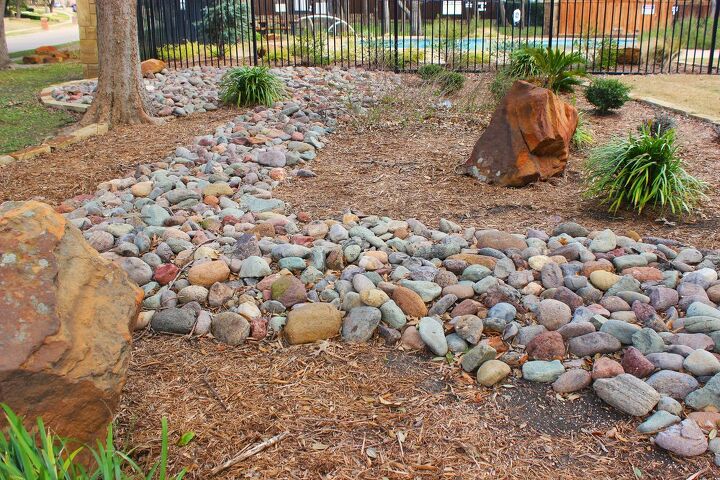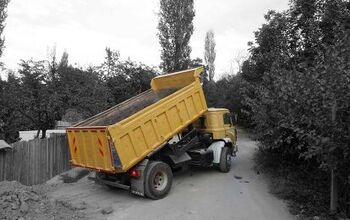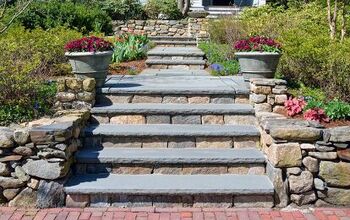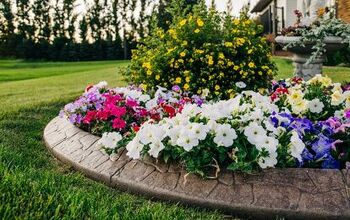How Much Do Landscaping Stones & River Rock Cost?

What kind of look are you aiming to bring to life in your yard? You can go for something casual or modern by adding the right fixtures and pieces of furniture. If your goal is to build a backyard with a beautiful natural aesthetic, you will need to introduce some landscaping elements.
River rocks and stones are among those landscaping elements that can transform your yard. They can frame flower beds beautifully and they can also serve as practical additions thanks to their draining capabilities. Decorating your yard with landscaping river rocks and stones is a great idea, but how much will it cost?
On average, the new landscaping river rocks and stones will cost $210 per ton. The type of landscaping stone you choose will greatly impact your material costs for this project. Landscapers typically charge $300 to install the new rocks and stones. Delivering the landscaping rocks and stones can also tack on an additional $60 to your bill.
Landscaping river rocks and stones bring a rugged dimension to your yard. It’s a type of look you cannot get from other design elements. Discover how much decorating your yard with those unique elements will cost you by continuing with the rest of this article.
Do You Need Mulch, Soil, Sand, or Rock Delivery?
Get free, zero-commitment quotes from pro contractors near you.

Cost of Landscape Rocks and Stones by Type
| Landscaping Rock or Stone Type | Cost Per Ton |
| Bull Rock | $85 |
| Crushed Granite Gravel | $80 |
| Crushed Limestone | $35 |
| Crushed Shells | $70 |
| Decomposed Granite | $40 |
| Landscape Boulders | $150 |
| Lava Rock | $160 |
| Mexican Beach Pebbles | $850 |
| Pea Gravel | $45 |
| Riprap | $75 |
| River Rocks | $170 |
| Rock Mulch | $140 |
| Stone Dust | $95 |
| White Stones | $900 |
Different kinds of landscaping rocks and stones can be used to decorate your yard. As you can see in the chart above, some landscaping stones are quite affordable while others are major investments. Get to know the available options better by reading through the entries below.
Bull Rock
Bull rock is the first type of landscaping material we’ll be discussing. You can purchase bull rock by the ton at the price of $85.
Most of the time, bull rock is used in plant beds as filler. These rocks have a rounded shape and that prevents them from being a threat to the plants. You can also take advantage of bull rock’s form to create a natural walkway. The rounded edges of bull rocks will not cause discomfort as you walk on them.
Color is another standout feature for bull rock. The light brown variants of bull rock stand out in a good way. They can bring more visual interest to the plant beds you’re creating.
Crushed Granite Gravel
At $80 per ton, crushed granite gravel is slightly cheaper than bull rock. It’s a type of landscaping stone that is valued more for its utility rather than its appearance.
Use crushed granite gravel to line your driveway or other pathways. Crushed granite gravel works well in that spot because it provides excellent drainage. You won’t be carrying water into your home with this landscaping material lining the perimeter of your property.
In terms of appearance, crushed granite gravel is not all that appealing. Consider using a different material if you’re more focused on beautifying your backyard.
Crushed Limestone
Crushed limestone could very likely be the most affordable landscaping stone that you’ll find in your area. You can get a ton of crushed limestone for just $35.
Don’t let the low price tag of crushed limestone trick you into thinking it’s an inferior landscaping material. That’s far from the case. The natural appearance of limestone is striking. If you get lucky with the limestone’s colors, you’ll end up with materials that can drastically transform your yard.
Functionally speaking, crushed limestone also works well if you need to add some stability. For drainage purposes, you can find superior materials, but crushed limestone will hold its own.
Crushed Shells
You can argue that crushed shells are the best landscaping materials to use in any yard. Priced at $70 per ton, crushed shells have a strong argument for being the best value purchases.
No other landscaping stone can replicate the appearance of crushed shells. Crushed shells feature unique markings. Those markings give your garden a more distinctive identity. Colors for crushed shells can be varied too. Many are on the lighter side, but you do get darker shells now and then.
Crushed shells also excel at preventing the growth of weeds. They also allow proper drainage. Use them to cover your yard and some of the leftovers can go into your aquariums.
Decomposed Granite
Homeowners can purchase decomposed granite for their backyard. A ton of decomposed granite costs $40.
Unlike the previous materials we discussed, decomposed granite doesn’t offer much in the way of looks. It features some interesting color variants, but that’s it. The rocks are too small to introduce an appealing textural element. You can opt not to get the decomposed granite sifted in the hopes of getting more texture, but that’s not enough.
All that said, decomposed granite is still useful as filler. Use it to add bulk to areas that would otherwise look and feel empty. It’s cheap enough that you should be able to use it often in that capacity.
Landscape Boulders
For $150, you can get a ton of landscape boulders for your backyard. Landscape boulders differ significantly from many other landscaping rocks and stones because of their size.
Compared to the other landscaping stones, the boulders are huge. They routinely measure over a foot in size. You can use them as landscape curbing and they will work well in that capacity.
Think carefully about where you want the boulders to be installed. Machines are often needed to move those boulders around. Place them in your preferred spots right away so you won’t have to pay additional installation costs down the line.
Lava Rock
Do you want landscaping materials that stand out for their appearance? If so, you should strongly consider buying some lava rocks. Lava rocks cost $160 per ton.
They aren’t called lava rocks for no good reason. The aforementioned landscaping materials are the result of cooled lava that has chipped into small pieces. Their origin is evident in their dark red hue.
One more thing worth noting about lava rock is how porous it is. You can use it to create borders in spots that get plenty of rain. It will help prevent the soil from getting saturated even during heavy downpours.
Mexican Beach Pebbles
Mexican beach pebbles are the second most expensive landscaping stones in terms of average price. You can expect to find Mexican beach pebbles sold for $850.
Why are Mexican beach pebbles so expensive? It’s due in large part to how they are gathered. Those Mexican beach pebbles have to be chosen carefully. It usually takes a lot of time and effort to collect the stones needed.
Are they worth all that effort and money? You can make that argument given the gorgeous appearance of the Mexican beach pebbles. They are so well-rounded that they almost look handmade at times.
Mexican beach pebbles cost a lot of money. That said, they can be worth it if you want to elevate the appearance of your backyard.
Pea Gravel
We’re going back to gravel for this next landscaping option. This time around, it’s pea gravel. You can buy a ton of pea gravel for $45.
The main use of pea gravel is drainage. The bits of gravel are just the right size to allow for efficient drainage. You can fill up plant beds with pea gravel if you want to ensure that they will not get flooded.
Go ahead and use pea gravel in other areas where you know water tends to pool. Lining parts of your yard with pea gravel should help reduce the amount of cleaning you need to do after rainstorms.
Riprap
Next up, you can purchase riprap as the rock covering for your yard. Riprap is priced at $75 per ton.
The defining quality of riprap is its texture. It’s rougher than most landscaping stones. You’ll often see riprap used to fill out slopes because its rough texture proves helpful in those spots.
Some homeowners also like using riprap because of their color. Riprap stones tend to feature very similar colors and that will help you create coordinated designs in your yard. Riprap is not the most exciting landscaping stone if you’re judging by appearance, but that can work to its advantage.
River Rocks
River rocks are the most varied among the landscaping stones you can purchase for your yard. The average cost per ton for river rocks is $170, but that can change depending on which subtype you choose.
Examples of subtypes you can buy include Arizona, Blue Montana, and rainbow river rocks. Prices do vary quite a bit so double-check that before making any purchase.
Although river rocks can come in different colors and sizes, they generally feature the same texture. They often have a smooth exterior. That smooth exterior is a big reason why homeowners use them for decorating.
Rock Mulch
Rock mulch can also be used for landscaping purposes. It’s also a pricey landscaping option at $170.
Did you picture layers of organic material contained within rocks when you thought of rock mulch? Well, that’s not exactly what you’re getting. Rock mulch is made of different types of landscaping stones. It contains pea gravel, crushed rocks, and some small stones too.
Suppliers give homeowners different options if they’re buying rock mulch. Homeowners can choose the color and size combos for the rock mulch. Be as picky as you need to be to ensure you get the landscaping stones you want for your property.
Stone Dust
Suppliers offer stone dust at the price of $90 per ton. If you’re wondering why homeowners would buy stone dust at that price, that’s because they value its strength.
Stone dust is an excellent material to use if you need to support the weight of something. Add the stone dust to a spot where you could use the additional support. Pack it down carefully around a fixture and you can stabilize that element of your yard.
You’ll also appreciate the fact that stone dust can fit into tight spots. It can provide support in places where no other materials might fit.
White Stones
Last but not least are the white stones. These are the most expensive landscaping stones as they cost $900 per ton.
White stones look a lot like Mexican beach pebbles and river rocks. They also feature a rounded form and their exterior is typically very smooth. The main difference between white stones and those other landscaping materials is the former’s color. White stones are also harder to find for that reason.
If you want to create spectacular settings in your yard, white stones will help out significantly. They can work as great decorative elements just about anywhere in your yard.
Cost to Install Landscape River Rocks and Stones
| Estimate Type | Cost |
| Low-End Estimate | $100 |
| Mid-Range Estimate | $300 |
| High-End Estimate | $800 |
After choosing the landscaping stones for your yard, you can now focus on installation. Professional landscapers typically charge $75 per hour to take on this type of job. For a typical four-hour installation, you’re looking at a fee of $300.
Hiring landscapers is a good idea if you want the installation to be completed quickly. Moving individual rocks is easy, but once you’re setting up your landscapes, the weight of the rocks can wear on you. Professionals can use heavy machinery to transport the rocks faster.
By the way, you may also want to account for delivery costs for the river rocks. The suppliers are likely going to charge you $60 for delivery. That price tag can also change depending on the location of your home and the number of stones being delivered.
Cost of Stepping Stones by Type
| Stepping Stone Type | Cost |
| Decorative Pavers | $18 Per Square Foot |
| Flagstone | $10 Per Square Foot |
| Pavers | $5 Per Square Foot |
| Rock Steps | $200 Per Piece |
Rocks and stones can take on different roles throughout your yard. As we’ve discussed throughout this article, they can be used as decorative elements and they fulfill different functions too. You can even create pathways throughout your yard using landscaping rocks and stones.
Those pathways can be made using stepping stones. Stepping stones can make navigating through your yard easier. You can use the stepping stones to avoid the mud when it’s raining outside.
Stepping stones can also be beautiful additions to your property. Those stepping stones tend to age gracefully. They will continue to look great even years after they were first installed.
Decorative Pavers
It’s now time to detail the available options for stepping stones. We can start with decorative pavers that are priced at $18 per square foot.
Decorative pavers are usually made out of stone, but they may feature other materials as well. Different materials may be embedded inside the paver to create a decorative flourish. A composite material is often used for that.
There are no restrictions on patterns that can be featured in decorative pavers if you’re willing to pay for custom pieces. If you’d rather not pay for custom pavers, you’ll often see floral patterns used as decorative finishes.
Flagstone
Flagstone is your next option if you’re laying down stepping stones. You can purchase flagstone from suppliers at the price of $10 per square foot.
Even if you’re not familiar with the term flagstone, you’ve likely seen it before. It’s the material often used to pave paths in parks and outdoor dining areas. Flagstone can be made from bluestone, limestone, or sandstone.
Flagstone usually has a smooth finish, but its shape is not that uniform. The edges of flagstone may be irregular thus causing some pieces to be bigger than others. Flagstone can also get slick when wet so be careful when walking on them in the rain.
Pavers
We talked about decorative pavers earlier, but you can also purchase regular pavers for your backyard. These are the items you need to look at if you’re looking for something budget-friendly. Pavers only cost $5 per square foot.
Unsurprisingly, the design of regular pavers is pretty basic. They are pieces of brick or concrete that are layered over your yard to create a pathway.
You can customize the appearance of your pathway by choosing the shape of the pavers. Go with rectangular pavers or items that are irregularly shaped if that’s what you prefer.
Rock Steps
Rock Steps are more elaborate stepping stones that can be installed in your yard. They don’t come cheap. You can buy Rock Steps per piece and each one costs $200.
Those Rock Steps can be preferable to the other options because of how durable they are. They are highly resistant to cracking and they are reinforced too. You can bank on those Rock Steps remaining in good shape for a long time.
There’s no denying the fact that Rock Steps are very expensive. Still, they can offer a great return on your investment due to their durability.
Cost to Remove Landscape River Rocks and Stones
| Estimate Type | Cost Per Hour |
| Low-End Estimate | $60 |
| Mid-Range Estimate | $100 |
| High-End Estimate | $150 |
Before you can start remodeling your yard, you may first have to remove some of the fixtures already in there. To be more specific, the landscaping river rocks and stones you installed previously may have to be removed. Professionals will charge an average rate of $100 per hour if you need landscaping stones taken out of your yard.
If you’re lucky, you might find professionals who will offer a more affordable rate of $60 per hour. On the flip side, some professionals may charge as much as $150 to take on that job.
Rock removal is often carried out because homeowners want to change the layout of their yard. A homeowner may want to add a pool but they have to remove a brick pathway before they can do so.
Some homeowners may also feel that it’s time to change up their backyard landscape. Removing the river rocks and stones will help facilitate that transformation.
Considerations before Installing Landscape River Rocks and Stones
Adding landscape river rocks and stones to your property is a major decision. As we just noted, you will have to pay a substantial amount if you want those landscaping stones removed.
You have to be certain that the landscaping stones fit in with your property plans before proceeding with the installation. Consider the points below carefully to find out if installing landscaping stones is a move you should make.
The Size of Your Yard
How big is your yard? Can you add landscaping or stepping stones without that outdoor area becoming cramped? Are you planning to add new fixtures down the line that the landscaping stones could potentially interfere with?
Those are all questions you need to answer before you decide on installing landscaping stones. They are also all related to the size of your yard.
Installing landscaping stones in a small yard can take away valuable space. Check if you have room for everything you want in your yard before adding the landscaping stones.
The Climate in Your Area
Landscaping rocks and stones are capable of retaining heat. That’s not necessarily a good thing.
The problem with the rocks and stones retaining heat is that they will need to release that at some point. As the day progresses, you may feel the temperature of your home rising as the rocks and stones continually release heat.
Consider the heat factor when deciding on landscaping stones. At the very least, you may want to keep the stones as far away from your house as possible. That should minimize the impact they have on your home’s temperature.
The Growth Potential of Your Yard
Installing landscaping rocks and stones will affect the number of plants you can cultivate in your yard. The stones are going to take up portions of the soil. You’ll have to sacrifice some of your soil if you want to accommodate the landscaping stones.
The landscaping stones will also not offer any nutrients to the plants you are growing. Carve out room for your plants so they can grow properly even with landscaping stones around them.
Sinking Potential
A notable downside to installing landscape stones and rocks is that they could potentially sink. Once they sink, they could deal lasting damage to your property.
Sunken landscape stones and rocks can still be professionally removed. You will just have to pay a hefty fee for that service.
Do You Need Mulch, Soil, Sand, or Rock Delivery?
Get free, zero-commitment quotes from pro contractors near you.

Related Questions
What Size River Rock Is Best for Landscaping?
The size of the river rock you need will depend on the application you have in mind. If you’re creating pathways, river rocks that measure 3/4 of an inch should suffice. For landscaping purposes, you want river rocks that are closer to an inch in size.
Do River Rocks Attract Snakes?
You may find your property visited by some unwanted guests if you have lined your yard with river rocks. Snakes are drawn to river rocks and they may visit your property.Setting up some fencing can help keep those snakes at bay. You should also keep your lawn short so the snakes have nowhere to hide.
Will Weeds Grow Through River Rocks?
Yes, weeds can still go through parts of your yard that are lined with river rocks. As long as the conditions are right for the weeds, they will manage to grow.
Related Guide

Gary Evans is passionate about home improvement. He loves finding out how to make improvements in the easiest, most practical, and most affordable ways. Upgrading his home kitchen is one of his ongoing hobbies. Gary is also a long-time content creator and enjoys spending his free time tending to his hydroponic vegetable garden.
More by Gary Evans






















![10 Most Dangerous Neighborhoods in Baltimore [Updated]](https://cdn-fastly.upgradedhome.com/media/2023/07/31/9075655/10-most-dangerous-neighborhoods-in-baltimore-updated.jpg?size=350x220)


![Standard Dining Room Table Dimensions [for 4, 6, 8, 10 and 12 People]](https://cdn-fastly.upgradedhome.com/media/2023/07/31/9074335/standard-dining-room-table-dimensions-for-4-6-8-10-and-12-people.jpg?size=350x220)

